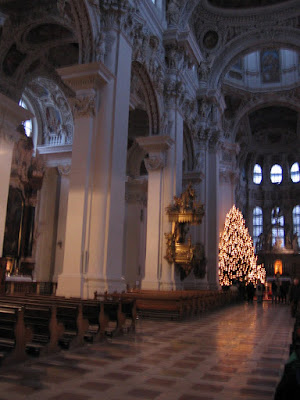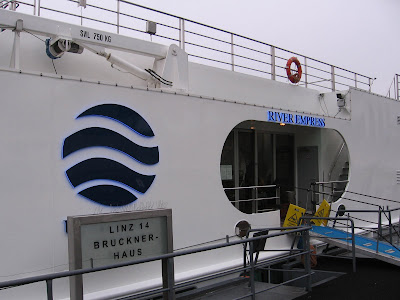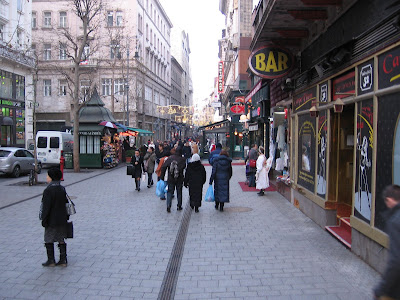
Here's the information with photos on the Christmas and New Year's Cruise we just took from Nuremberg, Germany to Budapest, Hungry on the ship River Empress sponsored by the travel company Uniworld.
We flew out of Dulles to Munich, Germany, from there it was a short commuter flight to Nuremberg where we joined our ship the River Empress floating on the Rhine-Danube Canal.
Our first stop upon arriving and getting settled in was the Nuremberg Christmas Market which is reported to be the best in Germany, we spent a lot of time there looking and shopping.
We were given several tours of the city while there but from having visited several times before we were very familiar with the place but there's always something new to be learned or new buildings and streets to be explored in every city no matter how much you might be familiar with it. In recent history because of its central location Nuremberg became the home of the great Nazi rallies and parades of the 30s, it was once a common sight to see great rivers of brown shirted storm troopers marching through the city.
During WWII the beautiful city of Nuremberg was more than 90% destroyed by allied bombing, the city has been totally rebuilt, except for a street or two little remains of the Nuremberg of old or of the Nazi rally sites. The one rally site remaining that most tours always take you to is the Zeppelinwiese, today it's little more than a neglected and crumbling ruin, looking more like an ancient Roman site than something of modern construction, certainly no longer the beautiful and imposing structure it once was.
The Nuremberg old town still has its old surrounding city walls, the Imperial Kaiserburg Castle, the Old Town Hall or Altes Rathaus, Our Lady's Church or Frauenkirche plus the Main Market and Beautiful Fountain called Hauptmarket & Schoner Brunnen. There's still plenty to see and enjoy in Nuremberg today.


































The next stop on our trip was to the city of Regensburg (Ratisbon). The area of Regensburg was once a Celtic settlement and later a campsite of the Roman legions, the outline of the Roman camp is still visible around St. Peter's Cathedral.
One great sight to see while in Regenburg would be the Steinerne Brucke, an outstanding example of medieval engineering, this 1000 foot long bridge over the Danube was built in 1135-46. It provides the best panoramic view of Regensburg. Near the bridge gate, Bruckentor, stands an enormous salt warehouse.
Another great sight would be the Wurstkuche (Wurstkuchel), immediately behind the salt warehouse is the famous Wurstkuche (sausage kitchen), which has probably occupied this site since as early as the 12th century and may have served as a canteen for the builders of the bridge. Regensburger sausages are definitely worth trying.
The Altes Rathaus (Old City Hall) in the Rathausplatz dates from the 15th century with a 13th century tower. It contains a richly decorated hall (Reichssaal) where the Perpetual Imperial Diet (the firs parliament of the Holy Roman Empire) sat between 1663 and 1806. Benches in the chamber where colored to indicate who could sit where: for example, red benches for Electors. the adjoining new town hall dates from the late 17th and early 18th century.
The Dom St. Peter towers above the city on the site of the former Roman military camp. The cathedral is a massive brick structure built between 1250 and 1525, its western towers were added in 1859-1869.
There are many other places in Regensburg to explore like the Alte Kapelle or Old Chapel really a Marian collegiate church. There's the churches and buildings of the former St. Emmeram Abbey which was the burial chapel and the Roman Porta Praetoria.
















After celebrating Christmas in Regensburg our next port of call on the Danube was the little university town of Deggendorf, other than to drive through Deggendorf we didn't have a chance to explore it instead we headed up through the Bavarian National Park to a country farming village where we were taken on a horse drawn carriage ride through the snow covered country side, it was a beautiful ride through the only snow we saw the whole trip, it seems Europe was having a mild winter like ours.
I was amazed by the Bavarian farm we visited, it appeared to be run like a farm in this country was operated back in the 1930s and 40s. I explored their barn and it was full of milk cows and recently born calves but there were no milking machines or any other forms of automation or modernization other than electricity, it appeared that all the milking was done the old fashioned way, by hand. The barn, the cows in wooden stanchions reminded me of my grandfather's farm back in the 40s, an amazing and very pleasing time warp.
I learned later that this farm also produced their own delicious home made bread in a wood fired outdoor oven, they let us all sample their bread and also sample a clear homemade liquor they produced and bottled on the farm called "Jager" made from locally grown root called Barivurz which was unknown to me, all I could think of to compare it to would be the white alcohol made in outdoor stills during Prohibition.
We left the farm and stopped at a small glass factory on the return trip to watch some glass blowers produce some fine German glass plus we got to tour their museum.







Our next stop on the Danube was Passau, Germany known as the city on the three rivers, the Donau (Danube), Inn, and Ilz rivers converge to form a larger Danube on its way to the Black Sea. Passau is a very old, very quaint and very lovely town and certainly worth the visit.
Upon arriving in Passau the first and most noticeable structure you see is the Fortress "Veste Oberhaus". The fortress was built in 1219 by Passau's Prince-Bishops in order to control commerce across the rivers. In the 19th century during the Napoleonic Wars the castle was one of the strongholds against the Austrians. Due to several changes over the centuries today's castle consists of Gothic, renaissance and baroque parts. The castle provides the best view of the city.
Other points of interest in the city that should be seen: St. Steven's Cathedral, Bishop's Residence, Old City Hall, Convent of Niedernburg (with tomb of St. Gisela), St. Michael's Church, St. Paul's Church, and many, many more. The magnificent St. Steven's Cathedral is an absolute gem, built on the old town's highest point. After it had burnt down almost completely in the devastating 1662 town fire, it was rebuilt in the baroque style all in white. The cathedral has a world famous pipe organ with 17974 pipes, 233 stops and 4 carillons, it's the world's largest cathedral organ.













Our next port on the Danube to stop at was Linz, Austria where travelers had their choice of either staying in Linz or getting a tour of Salzburg, since we had been to Salzburg and explored it thoroughly we opted to spend the day in Linz. Even though most cruise ships stop at Linz few actually tour the city and would rather bus their patrons to the more popular tourist city of Salzburg, after spending the day touring the sights of Linz we pretty much decided that most people are missing the boat when they miss seeing Linz. The city of Linz has much to offer and we had a great time there.
Linz is a town that is on both sides of the Danube with the historic old town on the right (south) bank. The vast Hauptplatz is regarded as one of Austria's most beautiful architectural complexes. We took a trip to a nearby hill, the Postlingberg from where there are great views of the town and river. On top of the Postlingberg mountain stands the pilgrimage church of Our Lady of Seven Sorrows, regarded as one of the main symbols of Linz built between 1738-47.
One of the most important sights would be the Martinskirche, Austria's oldest surviving church, dedicated to St. Martin. It was first mentioned in the 8th century, during the times of Charlemagne, as part of the Carolingians' former royal residence. The Gothic windows and portals date from the 8th century. There is an older Roman wall on the same site, and ten Roman tombstones, together with other ancient stones, were used as building material to erect the church. The interior also dates from the Carolingian period, the only later addition being the Neo-Gothic presbytery.
Other important sights in Linz would be the Alter Dom (Old Cathedral), the Neuer Dom (New Cathedral), Schloss (Castle), the Altes Rathaus (Old Town Hall) and many more sights



























Our next stop on the Danube was Durnstein, (Duernstein) Austria to get there we passed through the prettiest section of the Danube river gorge and the Wachau wine region with its many castles and abbeys along the way.
The town of Durnstein (Duernstein) is small but very scenic with its castle ruins towering on the mountain above the town. The castle walls snake down from both sides of the mountain to envelope the town which can be entered by the portals or gates in the walls. Sights to see in the town of Durnstein or Duernstein would be the Monastery Duernstein, Steiner gate and Painter's corner.
Climbing up the mountain to the castle is a must if you're physically fit, we managed to reach the top after many, many steps but took the road back. King Richard the Lion Heart was actually held prisoner there by some Austrian prince during the time of the Crusades making the castle famous.
Our tour guides pointed out another fact about the Duernstein area that isn't widely known and was only recently discovered by archaeologists, Napoleon fought a battle there against the Austrians and lost, one of the few battles he lost at that time.



















While docked at Durnstein we left the ship in the evening for an exclusive cocktail reception at Artstetten Castle with Princess Anita von Hohenberg who is a direct descendant of the royal Hapsburgs. The trip to the castle required about a 40 minute bus ride. Artstetten Castle was bought by Emperor Franz I in 1823, the castle has remained a family property until this day. The present owner is Princess Anita von Hohenberg, a great grand-daughter of Archduke Franz Ferdinand. The museum in part of the castle and was dedicated to the Archduke and opened in 1982, Princess Anita von Hohenberg and her family live in the other part of the castle.
There are many rooms open to the public in the castle, each room tells a part of the story of the history of the Habsburgs. One of the most interesting rooms is the crypt beneath the church which is part of the castle, Artstetten was intended as a widow's residence for the wife of Franz Ferdinand. Following the birth of a stillborn boy in 1908 at the Belvedere, Franz Ferdinand had a crypt built in Artstetten. This was enlarged and improved in 1917 when Artstetten became a centre of "pilgrimage". Following the death of the couple's son Ernst in 1954, a new Hohenberg crypt was added underneath the south terrace. This part of the crypt is not open to the public.





Our next sailing port of call on the Danube was Vienna, Austria. There's so much to see and do in this architecturally rich city it would take pages to list everything so only a few highlights can be mentioned here some of these highlights are well known and others rarely mentioned or seen but all are an important part of the history of Vienna.
We visited the Ringstrasse, once a wall around the old town but now a street circling the old town, the wall was torn down ages ago to make room for expansion. We strolled though the Holfburg grounds to the towering landmark St. Stephen's Cathedral. We visited the Baroque State Hall of the Austrian National Library, said to be the most beautiful library room in the world. We also visited the Imperial Crypt of the PP Capuchins where the personalities of the house of Habsburg are buried in Imperial Vaults and the Spanish Riding School to see the Lipizzaner's perform.
We toured Schonbrunn Palace, the former Habsburg summer residence, and saw the state rooms and private apartments of the imperial couple, Franz Joseph and Elisabeth. While at Schonbrunn Palace we also saw a puppet show at the Schloss Marionette Theater and later shopped at the Schloss Christmas market.
That evening we celebrated the New Year in grand style with a festive dinner and dancing in the magnificent Palais Pallavicini, which hosted performances by Mozart, Beethoven, and Salieri. Later, before the clock struck midnight we grabbed our coats and went to the streets with what seemed like a million celebrating Vienna revelers. The streets were so packed with people we had to take to the side streets to get through, it seemed there was a band on every corner entertaining some very inebriated spectators and uncontrolled fireworks being exploded all around us, we were wondering as we dodged firecrackers (the really big ones we used to call M-80s) if this is what the WWII battle of Vienna must have sounded like when the Danube river was the front line. This certainly was a memorable New Years, right up there with the one in Cologne a year or two before, the Europeans know how to have a good time and except for the firecrackers we felt completely safe the whole time as we made our way to the subway and back to the ship where there was still more fireworks displays all around our ship.
The next morning our tour guide gave us sort of an unconventional street car tour of Vienna, sights not often seen by the average tourist. One place he took us to left us speechless, they were the WWII flack towers, I had read about them but had never seen one in person but right in front of us was two of them. Two huge WWII flack towers standing side by side in a quiet Vienna park, the size of those things is immense, you really can't get a feel for their size unless you've seen one in person but there they were.
During WWII the German military built these towers in cities like Berlin, Hamburg and Vienna for air raid protection. They were heavily armed with anti-aircraft weapons but the allies learned of their existence and avoided them bombing Vienna anyway so except for the towers in Berlin they mostly served as civilian air raid shelters. These towers were virtually indestructible as the Russians found out in Berlin during the battle when they lined up there heaviest artillery against one of the towers there and fired away barely scratching the surface but eventually the soldiers in the tower had to surrender when they ran out of supplies, being among the last in Berlin to do so. Today many of the towers are still around as reminders of the war because of their total indestructibility.


































The final port of call before leaving for home was Budapest, Hungary. We docked below the Buda castle on the Buda side of the Danube River within easy walking of both the Buda and Pest sides of the river. The Pest side being the city side with all the shopping and the Buda side being the side with the castle.
As usual we had the city tour which featured the famous 19th century Chain Bridge, the first bridge to connect Buda with Pest. We went past the Great Synagogue, Hungarian National Museum, Hungarian State Opera House, St. Stephen's Basilica, Gellert Hill, Vaci Utca shopping district, and the stunning Parliament Building. We also visited the UNESCO listed Castle Hill district, St. Matthias Church, and the 19th century Fisherman's Bastion.
In WWII Hungary was allied with Germany and Budapest became a fortress, the battle that was fought in Budapest was one of the greatest and bloodiest of the war, there was little quarter given on either side with few survivors on the losing side, but today almost no sign of that great battle remains, just one building on the Buda castle side remains showing war damage from that time and on the Pest side war damage is even more difficult to discern as you walk the streets. For years after the war Hungary became a communist country behind the Iron Curtain and today it's a free and democratic country but some signs of those hard times remain today with the rundown appearance of their city in places.






























No comments:
Post a Comment